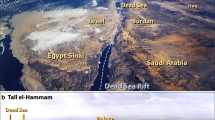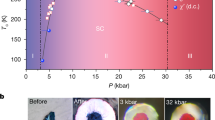Abstract
There are large amounts of heavy α-emitters in nuclear waste and nuclear materials inventories stored in various sites around the world1. These include plutonium and minor actinides such as americium and curium. In preparation for geological disposal there is consensus2 that actinides that have been separated from spent nuclear fuel should be immobilized within mineral-based ceramics rather than glass2,3,4 because of their superior aqueous durability and lower risk of accidental criticality. However, in the long term, the α-decay taking place in these ceramics will severely disrupt their crystalline structure2,3,4 and reduce their durability5,6. A fundamental property in predicting cumulative radiation damage is the number of atoms permanently displaced per α-decay. At present, this number is estimated to be 1,000–2,000 atoms/α in zircon4. Here we report nuclear magnetic resonance, spin-counting experiments that measure close to 5,000 atoms/α in radiation-damaged natural zircons. New radiological nuclear magnetic resonance measurements on highly radioactive, 239Pu zircon show damage similar to that caused by 238U and 232Th in mineral zircons at the same dose, indicating no significant effect of half-life or loading levels (dose rate). On the basis of these measurements, the initially crystalline structure of a 10 weight per cent 239Pu zircon would be amorphous after only 1,400 years in a geological repository (desired immobilization timescales are of the order of 250,000 years). These measurements establish a basis for assessing the long-term structural durability of actinide-containing ceramics in terms of an atomistic understanding of the fundamental damage event.
This is a preview of subscription content, access via your institution
Access options
Subscribe to this journal
Receive 51 print issues and online access
$199.00 per year
only $3.90 per issue
Buy this article
- Purchase on Springer Link
- Instant access to full article PDF
Prices may be subject to local taxes which are calculated during checkout



Similar content being viewed by others
References
International Atomic Energy Agency. (IAEA). Guidelines for the Management of Plutonium (INFCIRC/549): Background and Declarations 〈www.isis-online.org〉 (Institute for Science and National Security, 2003)
Muller, I. & Weber, W. J. Plutonium in crystalline ceramics and glasses. MRS Bull. 26, 698–706 (2001)
Weber, W. J. et al. Radiation effects in glasses used for immobilization of high-level waste and plutonium disposition. J. Mater. Res. 12, 1946–1978 (1997)
Weber, W. J. et al. Radiation effects in crystalline ceramics for the immobilization of high-level nuclear waste and plutonium. J. Mater. Res. 13, 1434–1484 (1998)
Ewing, R. C. Nuclear waste forms for actinides. Proc. Natl Acad. Sci. USA 96, 3432–3439 (1999)
Balan, E. et al. Metamictization and chemical durability of detrital zircon. Am. Mineral. 86, 1025–1033 (2001)
Wilde, S. A., Valley, J. W., Peck, W. H. & Graham, C. M. Evidence from detrital zircons for the existence of continental crust and oceans on the Earth 4.4 Gyr ago. Nature 409, 175–178 (2001)
Ewing, R. C. The design and evaluation of nuclear-waste forms: Clues from mineralogy. Can. Mineral. 39, 697–715 (2001)
Ewing, R. C., Meldrum, A., Wang, L. M., Weber, W. J. & Corrales, L. R. Radiation effects in zircon. Rev. Mineral. Geochem. 53, 387–425 (2003)
Holland, H. D. & Gottfried, D. The effect of nuclear radiation on the structure of zircon. Acta Crystallogr. 8, 291–300 (1955)
Farnan, I., Balan, E., Pickard, C. J. & Mauri, F. The effect of radiation damage on local structure in the crystalline fraction of ZrSiO4: Investigating the 29Si NMR response to pressure in zircon and reidite. Am. Mineral. 88, 1663–1667 (2003)
Balan, E., Mauri, F., Pickard, C. J., Farnan, I. & Calas, G. The aperiodic states of zircon: an ab initio molecular dynamics study. Am. Mineral. 88, 1769–1777 (2003)
Ashbrook, S. E. & Farnan, I. Solid-state 17O nuclear magnetic resonance spectroscopy without isotopic enrichment: direct detection of bridging oxygen in radiation damaged zircon. Solid State Nucl. Magn. Reson. 26, 105–112 (2004)
Magi, M., Lippmaa, E., Samoson, A., Engelhardt, G. & Grimmer, A. R. Solid-state high resolution 29Si chemical shifts in silicates. J. Phys. Chem. 88, 1518–1522 (1984)
Farnan, I. & Salje, E. K. H. The degree and nature of radiation damage in zircon observed by 29Si nuclear magnetic resonance. J. Appl. Phys. 89, 2084–2090 (2001)
Farnan, I. 29Si NMR characterisation of the crystalline-amorphous transition in ZrSiO4 . Phase Transit. 69, 47–60 (1999)
Rios, S., Salje, E. K. H., Zhang, M. & Ewing, R. C. Amorphization in zircon: evidence for direct impact damage. J. Phys. Condens. Matt. 12, 2401–2412 (2000)
Murakami, T., Chakoumakos, B. C., Ewing, R. C., Lumpkin, G. R. & Weber, W. J. Alpha-decay event damage in zircon. Am. Mineral. 76, 1510–1532 (1991)
Gibbons, J. F. Ion implantation in semiconductors. 2. Damage production and annealing. Proc. IEEE 60, 1062–1096 (1972)
Weber, W. J. Alpha-decay-induced amorphization in complex silicate structures. J. Am. Ceram. Soc. 76, 1729–1738 (1993)
Meldrum, A., Zinkle, S. J., Boatner, L. A. & Ewing, R. C. A transient liquid-like phase in the displacement cascades of zircon, hafnon and thorite. Nature 395, 56–58 (1998)
Trachenko, K., Dove, M. T. & Salje, E. K. H. Structural changes in zircon under alpha-decay irradiation. Phys. Rev. B 65, 180102 (2002)
Devanathan, R. et al. Molecular dynamics simulation of energetic recoil damage in zircon. Molec. Simul. (in the press)
Miller, M. L. & Ewing, R. C. Image simulation of partially amorphous materials. Ultramicroscopy 48, 203–237 (1992)
Farnan, I. et al. High-resolution solid-state nuclear magnetic resonance experiments on highly radioactive ceramics. Rev. Sci. Instrum. 75, 5232–5236 (2004)
Weber, W. J. Self-radiation damage and recovery in Pu-doped zircon. Radiat. Effects Defects Solids 115, 341–349 (1991)
Trachenko, K., Dove, M. T. & Salje, E. K. H. Large swelling and percolation in irradiated zircon. J. Phys. Cond. Matt. 15, L1–L7 (2003)
Ewing, R. C., Weber, W. J. & Lian, J. Nuclear waste disposal-pyrochlore (A(2)B(2)O(7)): Nuclear waste form for the immobilization of plutonium and “minor” actinides. J. Appl. Phys. 95, 5949–5971 (2004)
Larsen, F. H. & Farnan, I. 29Si and 17O (Q)CPMG-MAS solid-state NMR experiments as an optimum approach for half-integer nuclei having long T-1 relaxation times. Chem. Phys. Lett. 357, 403–408 (2002)
Zhang, M. et al. Metamictization of zircon: Raman spectroscopic study. J. Phys. Cond. Matt. 12, 1915–1925 (2000)
Acknowledgements
We thank N. R. Johnson, A. E. Kozelisky and R. D. Scheele for help with initial experimental development, sample handling and logistical support, and M. Zhang for help with the natural zircons. I.F. acknowledges funding from the UK EPSRC. A portion of the research described here was performed under a user programme at the Environmental Molecular Sciences Laboratory of the Pacific Northwest National Laboratory. PNNL staff and work were supported by the Environmental Management Science Program, Office of Biological and Environmental Research, US Department of Energy.
Author Contributions I.F. carried out the NMR work on natural zircons. I.F. conceived the radioactive MAS NMR experiments and I.F. and H.C. developed the technology and performed them in H.C.’s laboratory. W.J.W. provided the Pu zircon ceramics, supporting characterization data and radiological support. I.F. wrote the paper and all authors had a chance to contribute to and comment on the manuscript.
Author information
Authors and Affiliations
Corresponding author
Ethics declarations
Competing interests
Reprints and permissions information is available at www.nature.com/reprints. The authors declare no competing financial interests.
Supplementary information
Supplementary Figures
This file contains Supplementary Figures S1-S2. Figure S1 shows distribution of displaced atoms between crystalline and amorphous regions. Figure S2(a) shows saturation recovery T1 under static conditions and Figure S2(b) shows saturation recovery T1 under magic angle spinning. (PDF 553 kb)
Rights and permissions
About this article
Cite this article
Farnan, I., Cho, H. & Weber, W. Quantification of actinide α-radiation damage in minerals and ceramics. Nature 445, 190–193 (2007). https://doi.org/10.1038/nature05425
Received:
Accepted:
Issue Date:
DOI: https://doi.org/10.1038/nature05425
This article is cited by
-
X‐ray diffraction, differential scanning calorimetry and evolved gas analysis of aged plutonium tetrafluoride (PuF4)
Journal of Radioanalytical and Nuclear Chemistry (2021)
-
Short-range order and electronic structure of radiation-damaged zircon according to X-ray photoelectron spectroscopy
Physics and Chemistry of Minerals (2020)
-
Irradiation effects in monazite–(Ce) and zircon: Raman and photoluminescence study of Au-irradiated FIB foils
Physics and Chemistry of Minerals (2018)
-
Radiation-induced effects on the mechanical properties of natural ZrSiO4: double cascade-overlap damage accumulation
Physics and Chemistry of Minerals (2018)
-
In situ TEM observation of alpha-particle induced annealing of radiation damage in Durango apatite
Scientific Reports (2017)
Comments
By submitting a comment you agree to abide by our Terms and Community Guidelines. If you find something abusive or that does not comply with our terms or guidelines please flag it as inappropriate.



